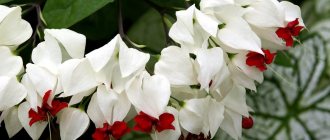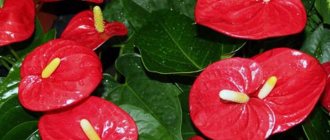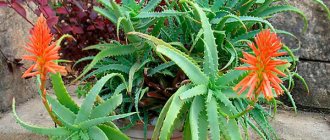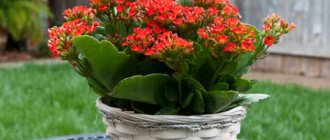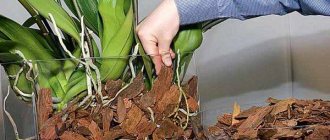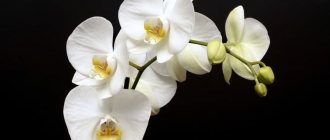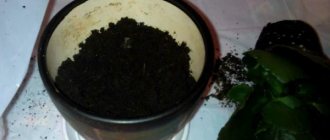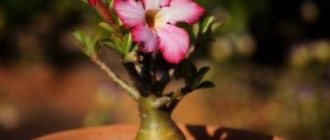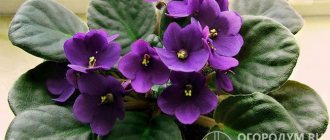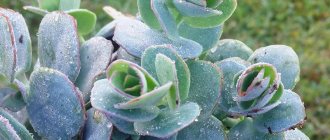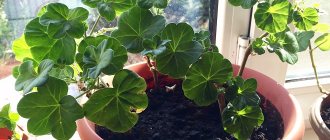The fashion for flowering Kalanchoes began in the 80s of the 20th century. Then the Kalanchoe blossfeldiana variety group Kalandiva was presented at auctions in Holland. Since then, the crop has been considered the most popular - beautiful, easy to care for, and retains its decorative effect for a long time. In the West, after the buds wither, the bush is thrown away, considering it a short-lived bouquet plant. It is not customary to do this in Russia or neighboring countries. But most lovers have a question: why doesn’t Kalanchoe bloom again?
What varieties of Kalanchoe bloom?
Kalanchoe, a common plant in Asia and Australia, can only be found in Russia at home. Unpretentious succulents with fleshy carved leaves, when properly cared for, decorate window sills with the bright colors of their inflorescences.
Kalanchoe has more than two hundred different varieties. Among them, the most popular are medicinal and flowering species. The bright, varied colors of the buds, the compact shape of the bush and multi-colored carved thick leaves attract the attention of amateur gardeners.
Depending on the variety, Kalanchoe has different forms of inflorescences, and the spectrum of their colors covers almost the entire color gamut, from snow-white to rich dark burgundy tones. The following varieties are considered the most popular for indoor cultivation:
- Mangina . It blooms at home with rich red or pink buds collected in large inflorescences. Leaning down, they resemble large bells. Mangina inflorescences are considered one of the largest among Kalanchoe.
- Kalandiva . A small bush throws out many small inflorescences. The abundance of bright double flowers and ease of care make it a favorite of many gardeners.
- Degremona . An interesting variety was brought from the island of Madagascar. It has unusual leaves that surprise with their structure and color. Has medicinal properties. Blooms with large, purple buds.
- Blossfeld . A low variety of the crop blooms with lush, bright red flowers hanging down. Each inflorescence consists of several dozen large flowers.
- Lucia . At first glance, a rather inconspicuous variety, when blooming, turns into a magnificent golden ball. After the last flower withers, the plant dies.
Content Features
Kalanchoe without flowers does not look very presentable. With proper care, the compact bush quickly produces buds. Thanks to the work of breeders, they can have different shades.
Flowers can have different colors
Flowering frequency
As a rule, Kalanchoe blooms at the end of January and continues until the end of spring. But there is a special technique that allows you to extend this period until September.
For your information! Under the right conditions, the succulent sheds flowers and gains new buds; this can happen once a season. If maintained poorly, the plant will not develop.
Some types
Thanks to selection, it was possible to develop several hundred varieties of Kalanchoe.
- Kalandiva is distinguished by its miniature size. The height of the variety rarely exceeds 30 cm, and the stems are densely strewn with small flowers of different shades.
- Degremon is capable of growing up to one meter in height. It has bright leaves: the inside is gray-green and the outside is dark green. It blooms rarely and only in winter, the inflorescences are paniculate.
- Laciniat has an unusual leaf shape. They resemble branched deer horns and are painted a rich green color. This species has no color and is attractive only for its feathery leaves.
- The dissected variety also has similar characteristics. Paniculata Kalanchoe attracts attention with its round silvery leaves. Small inflorescences appear only in April or May.
The mix variety has different flower colors - white, pink, lilac, etc.
Note! Kalanchoe has double inflorescences, that is, consisting of many petals, which makes indoor plants decorative and beautiful.
When does Kalanchoe usually bloom?
Kalanchoe, like many succulents, blooms once a year. It is important that it can bloom in winter, when there is little color and light around.
The plant pleases with its inflorescences for quite a long time. Usually buds form in January - February.
REFERENCE. At home, the culture blooms until mid-spring. Blooming Kalanchoe decorates the winter landscape outside the window.
Why doesn't Kalanchoe bloom?
When purchasing flowering varieties, you can often encounter the fact that the crop does not begin to bloom at home. There are many reasons that prevent bud formation, however, some of them play a key role in the process of laying future flowers.
Insufficient lighting
Kalanchoe may not bloom if the lighting conditions are disrupted. After flowering, during the dormant period, the plant requires good lighting. High-quality lighting affects the state of the crop. The leaves acquire a bright, rich color.
Before flowering, daylight hours should be reduced to 8 hours. Otherwise, it will not be possible to force the buds to form.
Incorrect temperature
Although Kalanchoe is considered an unpretentious crop, however, unfavorable temperatures do not allow flower buds to form.
The optimal temperature for Kalanchoe to bloom should not exceed 200C at night, and 270C during the day. During the dormant period in autumn, it is advisable to create cool conditions. The optimal temperature is considered to be not exceeding 170C.
There is no winter dormancy period
In order to make Kalanchoe bloom, it needs to create a period of rest. To do this, remove it to a cool, shaded place and reduce watering.
In such conditions, the flower is kept for 3 to 5 weeks. Then they return it to its place and begin to water it regularly.
Irrigation conditions are violated
Kalanchoe is a succulent. It has fleshy leaves that can accumulate moisture for future use.
Like any succulent, it’s better to under-water than over-water. However, regularly drying out a clod of soil in a pot at home does not allow the buds to form normally and leads to their shedding.
It is necessary to water when the top layer of soil dries out by 3-4 cm. Watering should ensure that the earthen clod is completely wet. The pot must have high-quality drainage, which protects the roots from stagnant moisture.
Presence of a draft
Kalanchoe can easily survive unfavorable conditions, but will not bloom. Drafts are one of the factors that reduce the likelihood of bud formation. When choosing a place for your green pet, you need to pay attention to the presence of random drafts.
Inappropriate soil
If a succulent is planted at home in nutritious and acidic soil, the development of buds will slow down or not occur at all.
REFERENCE. All succulents love light sandy mixtures with a neutral or slightly alkaline pH. It is important to fertilize in a timely manner. Their excess or deficiency will also lead to a lack of flowering.
Presence of diseases
A specimen affected by disease or pests devotes all its strength to survival. It most likely will not be able to bloom.
At the slightest suspicion of a disease, it is necessary to carry out treatment at home with special means. It is advisable to regularly spray Kalanchoe with insecticides against parasites and fungicides for diseases for prevention, without waiting for alarm signals.
Inappropriate humidity
Succulent leaves are designed to store water, which they get from the air. Therefore, humidity plays an important role in the well-being of Kalanchoe.
In dry rooms, it is advisable to place containers with water next to the pot. In hot weather, you can spray or rinse the flower in the shower. It is not advisable to spray in winter.
Big pot
It is not advisable to plant Kalanchoe in a large, empty pot. The presence of a large supply of soil provokes the development of a large number of leaves.
At the same time, it is almost impossible to force it to bloom. The pot must be purchased according to the size of the root system. It should exceed the root ball by 4 - 5 cm.
Diseases
Diseases of Kalanchoe are rare, but fungal infections still occur occasionally. Usually, an indoor flower can cope with the disease on its own if watering is reduced.
If the plant is severely infested, it can be helped by treating it with a fungicide and creating a gentle watering schedule. Since the soil can also be infected with a fungus, it needs to be completely changed, the root system inspected and dead parts removed. With the right approach, recovery will not take long.
If you pay attention to Kalanchoe, it is quite easy to understand the reason for the lack of flowering. By following certain recommendations, you can change the situation in your favor and wait for bright flowers to appear on your indoor plant.
Kalanchoe does not bloom and stretches out, what should I do?
Often, having purchased a flowering crop in a store, or received it as a gift, people are faced with the fact that it does not bloom again.
The branches stretch upward, the culture develops, but flower buds do not form. The main reason for this phenomenon is considered to be impaired light conditions.
In autumn, during the flowering period, natural light is not enough for the formation of buds.
You can help your green pet by providing additional lighting. To do this, turn on the lamps in the room in the morning and evening or illuminate the windowsill with stationary phytolamps.
This will force the Kalanchoe to form buds more actively.
Diseases and pests: treatment methods
Diseases of this type of Kalanchoe are mainly associated with improper care. So, with a lack of light (as well as on hot summer days), powdery mildew may appear on the plant - large white spots on the leaves. They should be treated with fungicides.
If kept in a damp, cool room (or waterlogged soil), root rot, gray mold and late blight may appear. In these cases, treating the plant with fungicides will also help.
The most common pests that attack Kalanchoe are:
- aphid;
- scale insect;
- mealybug.
In these cases, the plant is treated with insecticides or other special products sold in stores. In this case, it is advisable to use water-soluble drugs, because Many insecticides contain xylene, a substance that adversely affects Kalanchoe.
How to make Kalanchoe bloom profusely if all conditions are right
Having provided good conditions for Kalanchoe, you can wait for the long-awaited flowering. And the use of additional techniques can make this flowering more abundant and lush at home.
- After the flower stalks fall off, Kalanchoe needs to be fed regularly. You can use ready-made mixtures for succulents and bearberries.
- About a month after flowering it is necessary to prune. Remove old and diseased shoots. Pinch off the growing points on young branches. Pruning allows you to shape the crown of the bush and prevents it from stretching. In addition, this will force the Kalanchoe to produce new flower stalks.
- Night temperature should not exceed 200C. Otherwise, the formation of flower buds may slow down, and the inflorescences will be few and far between.
- In autumn, in cloudy weather, it is advisable to use additional lighting to make the crop bloom.
Temperature
For growing Kalanchoe, a room with a temperature range from 16 to 25 degrees is suitable. If there is a short day, additional lighting can be used. For flowering in winter, the temperature can be reduced by putting the plant into a dormant state. Here the optimal temperature will be from 10 to 15 degrees. In this case, you need to reduce watering to 1 time per month. The formation of an earthen coma is even allowed. In summer, the flower can be planted in the garden. Digging is carried out only together with the pot, otherwise the plant will grow greatly.
Separately, it is worth noting that Kalanchoe has a negative attitude towards heat flows. Therefore, it should not be left in front of open windows. You should also keep the pot away from heating appliances.
Rules for caring for Kalanchoe so that the flower blooms
In order for Kalanchoe to bloom, it is necessary not only to create good conditions, but also to properly care for it. High-quality care includes timely watering, replanting, pruning and fertilizing the flower at home.
- Watering . Kalanchoe loves water, but does not tolerate stagnation. Therefore, watering should be done no more than once a week. It should be quite abundant, but water should not accumulate in the soil.
- Transplant . In spring, it is better to replant faded Kalanchoe. To do this, select a pot that is 3-4 cm larger than the old one. You can plant Kalanchoe in a ready-made soil mixture for succulents or prepare the soil yourself. The soil must be neutral in acidity; sand is added to it.
- Feeding . Fertilizers at home are applied to the soil every month in the spring and summer. When using purchased products, you must strictly follow the dosage recommendations.
- Trimming . Flowering varieties of the crop require constant pruning. The main pruning is carried out after flowering, when the flower stalks are completely cut out and 2-3 lower leaves on the stems are removed. The tops of the shoots can be pinched, this will provoke the formation of side shoots. The bush will be more lush and bloom profusely.
Tips and Tricks
There are tricks, the use of which can make a flower bloom even when there is no hope left. To make the crop bloom, you need to follow these steps.
- A month before the expected flowering, you need to remove the plant to a cool, dark place.
- Stop feeding and watering the Kalanchoe.
- After a month, return the flower back to the room, avoiding places with direct sunlight.
- Resume watering the plant, after moistening it only by spraying for a week.
Stress will cause the plant to produce new shoots and set flower buds.
No rest period
For proper growth and flowering, the plant needs a period of rest. It is usually organized in September or October so that the flower has time to bloom by winter. The rest period lasts one month.
To organize the flower's rest, it is necessary to limit its watering and reduce the temperature to 12-15°C . In such conditions, it hardly grows or stretches without intense sunlight. Some experienced gardeners recommend keeping the plant in complete darkness at this time and not watering it at all. After the end of dormancy, the flower is gradually transferred to the normal watering regime.
Growing Kalanchoe all year round at room temperature and regular watering, it is almost impossible to achieve flowering.
In winter, it becomes very elongated without sunlight; only weak shoots grow on it, which never produce flowers. And after a month of keeping it cool with limited watering, the flower begins to intensively grow buds.
Common mistakes
Often thinking that Kalanchoe is unpretentious, novice gardeners make a number of mistakes that prevent the plant from blooming.
- Excessive watering with stagnant water leads to rotting of the roots.
- Growing in a cold, ventilated window.
- Insufficient lighting intensity.
- Dry indoor climate.
- Lack of a dormant stage in the plant.
By eliminating such mistakes, you can easily make Kalanchoe bloom profusely and for a long time at home.
Reasons for the lack of flowers
If a Kalanchoe stands without flowers, this is usually due to a violation of its maintenance standards. In most cases, inexperienced people simply sparsely water the plant and do nothing else with it. Flowering requires proper care. Most often, the main problems with Kalanchoe budding are associated with the following disorders:
- low room temperature;
- insufficient lighting;
- violation of the irrigation regime;
- excess or lack of nutrients;
- refusal to trim the plant;
- lack of rest period;
- untimely transplantation.
Also, Kalanchoe may stop blooming due to the fact that it is an ordinary annual hybrid - you can only find out the exact information from the seller. Diseases and pests rarely affect succulents; usually the plant copes with such problems on its own. The only exception is aphids. To combat it, you will need to treat the plant with insecticides.
Answers to frequently asked questions
Having purchased a Kalanchoe, many novice gardeners have a number of questions about how to care for it. Most often people are interested in the following problems.
What to do if Kalanchoe wilts?
Answer: Leaves of a crop can lose their elasticity in two cases. Severe water deficiency and disease. In the first case, it is enough to wet the roots of the plant well; in the second, treatment with medicines is necessary.
Why do you need to pinch the tops of the shoots?
Answer: Pinching the apical growing points will cause the shoots to branch. Namely, flower buds are laid at their ends. The more branches are formed, the richer the Kalanchoe will bloom.
Do I need to feed Kalanchoe when it blooms?
Answer: When the flower blooms, it is not recommended to feed it. Fertilizers are applied during the period of intensive development of green mass. This is spring or summer.
